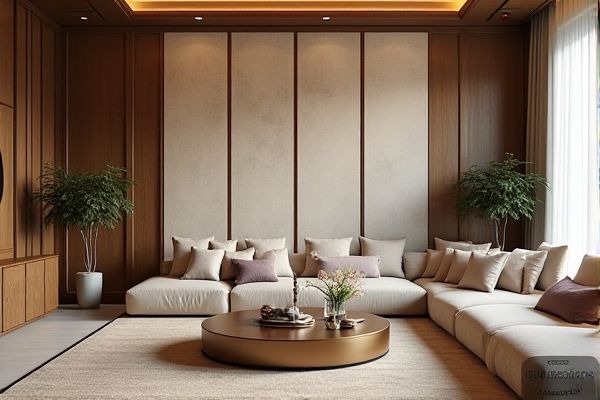
Screen dividers and panel dividers both serve to create separate spaces, but screen dividers are typically freestanding and portable, made from lightweight materials for easy repositioning, while panel dividers are often fixed or semi-permanent, designed to provide more robust partitioning in offices or homes. Understanding these differences can help you choose the right solution for your space needs--explore the rest of the article to discover which option suits your environment best.
Table of Comparison
| Feature | Screen Divider | Panel Divider |
|---|---|---|
| Purpose | Provides privacy and defines space in rooms | Separates areas with structural or decorative panels |
| Material | Wood, fabric, metal, plastic | Wood, glass, metal, composite materials |
| Portability | Lightweight and movable | Usually fixed or semi-permanent |
| Installation | No installation, free-standing | Requires mounting or framing |
| Design | Varied designs, folding options | Solid or decorative panels, fixed shapes |
| Use Cases | Home, offices, temporary setups | Offices, commercial spaces, permanent room divisions |
| Cost | Generally affordable | Can be expensive depending on materials |
Introduction: Screen Divider vs Panel Divider
Screen dividers offer flexible, portable partitions ideal for creating temporary private spaces, while panel dividers provide sturdy, fixed solutions designed for long-term separation in offices or rooms. Your choice depends on whether you need mobility and ease of setup or durability and permanent structure. Both options serve to enhance privacy, control noise, and define areas efficiently.
Key Differences Between Screen Dividers and Panel Dividers
Screen dividers consist of multiple connected panels that fold and are portable, providing flexible space division and easy storage. Panel dividers are typically fixed or larger standalone units designed for more permanent separation, offering enhanced stability and often incorporating soundproofing features. Your choice depends on the need for mobility, space flexibility, and the level of privacy required.
Material Comparison: Screen Divider vs Panel Divider
Screen dividers are commonly made from lightweight materials such as fabric, wood, or bamboo, offering portability and aesthetic versatility, while panel dividers typically utilize sturdier materials like glass, metal, or composite wood, providing enhanced durability and structural stability. The choice of material in screen dividers emphasizes ease of movement and decorative appeal, whereas panel dividers focus on sound insulation and long-term functionality in office or commercial environments. This material distinction directly influences the divider's suitability for residential versus professional settings, impacting maintenance requirements and overall performance.
Space Utilization: Which Divider Is More Efficient?
Screen dividers offer flexible space utilization by creating temporary, movable boundaries that can be easily adjusted or reconfigured to suit changing needs, making them ideal for dynamic environments. Panel dividers, while often more solid and permanent, maximize efficiency in defining distinct areas and provide better sound insulation, contributing to focused, private spaces. Your choice depends on whether you prioritize adaptability or long-term, stable partitioning for optimized space use.
Aesthetic Appeal: Design Options and Styles
Screen dividers offer diverse design options, including intricate patterns, vibrant colors, and lightweight materials that enhance aesthetic appeal in modern interiors. Panel dividers tend to feature more solid, structured styles, often crafted from wood or glass, contributing a sophisticated and formal look to spaces. Both options allow customization, but screen dividers excel in providing artistic and flexible styles, while panel dividers emphasize elegance and permanence.
Functionality and Flexibility
Screen dividers offer greater flexibility by enabling easy reconfiguration of spaces and providing lightweight, portable barriers ideal for temporary separation. Panel dividers, often more rigid and permanent, deliver enhanced sound insulation and privacy, making them suitable for fixed office layouts or defined room separation. Your choice depends on whether you prioritize adaptability with screen dividers or stability and acoustic control with panel dividers.
Installation and Portability
Screen dividers typically feature lightweight frames and foldable designs, allowing for easy installation and portability, making them ideal for temporary or frequently changing spaces. Panel dividers often require more fixed installation, sometimes involving mounting hardware or interlocking components, which can limit their mobility but provide greater stability. The choice between screen and panel dividers depends on the balance between ease of setup and the need for a durable, semi-permanent partition.
Cost Analysis: Budget Considerations
Screen dividers typically offer a cost-effective solution for temporary or flexible space separation, with prices ranging from $50 to $200 depending on size and materials. Panel dividers usually involve higher upfront costs, often between $200 and $500, due to their fixed installation and more durable construction. Budget considerations should weigh the intended usage duration and the need for mobility against initial investment and maintenance expenses.
Best Use Cases for Screen Dividers and Panel Dividers
Screen dividers excel in creating temporary, flexible partitions in open spaces like offices or homes, providing privacy and reducing noise without permanent alterations. Panel dividers are ideal for more structured environments, offering sturdy, often decorative separation that supports organization in commercial settings such as conference rooms or retail areas. Each type enhances spatial management by addressing specific needs--mobility and adaptability for screen dividers versus durability and design integration for panel dividers.
Conclusion: Choosing the Right Divider for Your Space
Screen dividers offer flexible, portable solutions ideal for temporary or changing spaces, while panel dividers provide sturdy, permanent partitions perfect for defining fixed areas. Your choice depends on the desired mobility, durability, and style compatibility within your environment. Consider factors like space size, privacy needs, and aesthetic preferences to select the divider that best enhances your room's functionality and design.
 homyna.com
homyna.com